Personal Note: This past fall I travelled to England to do book research and vacation. The itinerary left time to investigate topics of interest to wargamers. Most of what follows concerns the Napoleonic period. If you are not interested, skip to the last section devoted to making terrain and playing games.
THE REGIMENTAL MUSEUMS
The regimental museums are scattered throughout England, each one providing a sometimes bewildering panoply of a unit's military history. One sees a grenadier's helmet worn at the battle of Minden lying next to a Lewis machinegun used in the trenches in Flanders in 1915. It's hard to stay focused on one's period of interest. Gamers interested in the Colonial period will find many fine displays of uniforms, equipment, sketches, and old photographs. For example, I visited Nottingham Castle to pursue an interest in the 45th Regiment which served with great distinction in the Peninsula. Mounting one set of stairs I came face to face with a Zulu shield and spears captured from the Zulu King at the Battle of Is.
When visiting the Buff's Museum I encountered a wonderful Colonial diorama full of hard fighting lead soldiers engaging hordes of Sudanese. The scene depicted an important moment when a certain ensign seized a Sudanese flag from a large, fierce turbaned warrior. Turning to the opposite wall I saw the actual battle flag! Each museum reminds the viewer of Britain's incredible military history.
The Nottinghamshire Museum contains some fascinating Peninsular relics. A drummer's shako displayed next to a private's shako reveals an interesting detail. The drummer's brass shako badge lacks the regulation crown. The reason: the drummer boy was so much smaller than the full grown soldiers that he had to wear a smaller shako that didn't have room for the regulation badge!
A beautiful Ensign's uniform demonstrates the lack of standardization in the Duke's Army. Forest green collar, cuffs, and a large buttoned back lapel showing only on the left side of the chest; white turnbacks; knee high calf skin boots and white pants complete this attractive, decidedly unregulation uniform. A chilling note tells the viewer that this uniform was taken from the Ensign's body after he died on a scaling ladder at Badajoz.
If you are able to travel to England, be sure to visit the regimental museums.
THE NATIONAL ARMY MUSEUM
If one visits London this museum is a must. Serious researchers must receive written authorization in advance to use the archives. But it is well worth the trouble. During work on my 1809 book I checked references to a few other items of interest. After some digging I had in my hands the original copy of a French divisional commander's returns (number of men present, their status, etc.) captured by Spanish guerrillas while on its way to Paris and forwarded to Wellington for his analysis! I felt like I was literally touching history.
Another file contained General Cole's handwritten letters to friends and relatives describing his participation at the Battle of Maida in 1806. A folio contained color sketches of the captured flags hanging from the Chelsea Pensioner's Hall in the mid 1800s. It's a bit embarrassing to have to do one's research on War of 1812 American flags in London!
For visitors not interested in the archives, the museum has many wonderful displays including original uniforms and equipment. Special exhibits change from time to time; during my visit the Commandos were featured. Entering the hall one sees a life sized wax commando creeping up behind an unwary German sentry. The commando carries a knife and is dressed in camouflage kit with blackened face. The guard stands in a ruined cottage with rifle slung, gazing out to sea, a half-empty bottle propped next to him. one shudders to realize this is how it was; a bored half-drunk fellow about to be knifed in the back.
SANDHURST
At Sandhurst, Britain's West Point, Paddy Griffith takes me on a quick tour. There are French 12 pounders captured at Waterloo. Here is the chapel full of plaques honoring Sandhurst graduates fallen in battle. Paddy notes with a twinkle in his eye that it's ironic to attend chapel with the entire student body singing lustily away while surrounding them is hard evidence of the fate of their predecessors. in the chapel current pride of place is reserved for an officer tortured to death in Northern Ireland.
Retiring to Paddy's house I learn about his current wargaming efforts. His just published "Battle in the Civil War" is the first of a series of 'field books' intended for all periods of military history from ancients to modern and to be directed at the wargamer. According to the back cover, the book is " a step-by- step explanation of how the Blue and Gray armies squared up to fight each other; how they maneuvered on the battlefield, and what happened when they came to close combat."
Profusely illustrated with drawings and sketches, the field books promise to be a real boon to the wargamer. For example, the Civil War book addresses command and control problems in a clear manner that should give all gamers some ideas to reflect upon. It would not be a Paddy Griffith book if it were not controversial. The author posits that in spite of the increased lethal range of the rifled musket, typical combat occurred in wooded terrain where neither side had an unobstructed view. Consequently they were seldom able to use their long range weapons.
The result was combat much like Napoleonic combat with the issue decided in the last 100 yards. Perhaps my short summary does not do justice to Paddy's research, so read the book. Once you see it I'm sure most will agree that the Field Books promise to be a valuable resource for the wargamer.
As I leave I tell Paddy (knowing his delight in the iconoclastic view) of my work on an article devoted to Ney's tactics at Quatre Bras entitled "Quatre Bras; Ney's Combined Arms Triumph?". Paddy goes me one better: "Ah, interesting. But wouldn't it be something if you could show that combined arms attacks didn't work?"
DOVER CASTLE/WATERLOO
Heading across the Channel to Waterloo, I stopped at Dover Castle. The castle houses Siborne's original terrain table based on his visits to the battlefield in 1815 and his extensive research with Waterloo veterans. His master table lies in pieces in some museum's basement, waiting for funds for renovation. This table, some 25 feet long and 8 feet side, is devoted solely to the British position at 2 P.M. just as the cavalry attacks D'Erlon's men. The sculpted terrain competes favorably with the most modern terrain boards. The hundreds of painted figures are well rendered. However, they show the dangers of improper priming of unpainted figures. Lead rot, a grey fuzziness that peels the paint away, attacks many stalwart figures who have stood frozen in time for close to 150 years. A vacuum glass cover seals the table to prevent further rot. A lively tape narrative by David Chandler explains the situation. Whether one intends to visit Waterloo or not, Dover Castle is well worth a visit.
I had not been to Waterloo for some 17 years. Friends told me to go now if I ever wanted to visit a second time because development from Brussels is making serious inroads on the battlefield. Sadly, they are right. A booming super highway runs just behind the main British defensive position. Apartment buildings tower next to the church at Placenoit. Still, much of this can be blocked out and the field continues to reward the serious visitor.
A word of warning for the first-time visitor: do not expect a National Park Service-type layout. Like all European battlefields, very few markers dot the terrain. The visitor must do most of the work himself. Extremely helpful resources include David Howarth's guide to the battlefield (the best source for a one-day visit, the guide takes one to five locations and explains what can be seen from each), and David Chandler's book on Waterloo (the maps are a bit confusing; I did find the 'covered mound outside of Ligny with the panoramic view' or something, somewhere else, and where was the confounded original bridge through Genappe?). Still, armed with Howarth, Chandler, Weller, Siborne, and the Dover Castle Diorama I was able to reconstruct events fairly well. If you plan on visiting, go soon. The field is being developed.
POLYSTYRENE TERRAIN, RESIN CAST BUILDINGS
Integral Terrain with its lightweight polystyrene (styrofoam) terrain boards is very popular in England. The boards feature a special flocking technique that somehow keeps the flock secured to the board even when rubbed vigorously. A rival, but compatible product is Total System Scenic. Ranging in price from about $6.00 for a plain grassland to $15.00 for a Cliff face with shelving beach, most TSS boards cost $7.00 to $8.00. The two foot square blocks are nicely made and certainly anyone Willing to invest in a complete set of either product or mix the two together, would have a very nice table setup indeed.
I planned to make my own, but Martin, the amiable owner of Total System Scenic, dissuaded me. To do it on a big scale one needs a 'hot wire' cutting machine and a fume cover to vent the poisonous fumes. Securing the flock requires a glue machine to evenly squirt out the glue and another machine to rain the appropriate flock down. it's easy if you have the equipment. My impression is that it's tough if you don't. A nice trend in the Total System Scenic approach is increased flexibility with 'lay ons' that convert the basic terrain into more complex terrain. For example, a slope section can be set between a ridgeboard and a stream board so the slope descends naturally all the way to the stream, but if the stream is not bordered by ridges the slope section can be removed.
Martin's shop also gave me my first look at the 'Hovels' resin buildings. Heretofore, Gallia products have justifiably dominated this market. Hovels provide a nice contrast to Gallia buildings. While Gallia tends to be straight lines and rigid angles, Hovels have more natural looking irregular lines. The wall maybe slightly crooked; the roof bowed under the weight of the years. (Ed. Note: "Hovels" are available in the U.S. from Stone Mountain - see advt. elsewhere in this issue.)
THE ENCHANTED COTTAGE
Peter Gilder is probably the world's only professional wargamer. He left a corporate job in Hull many years ago to test out a belief that a market existed for putting on wargame weekends and week long vacations for the public.
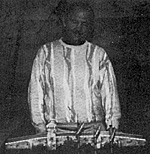 Peter Gilder emerges between tables at his "Enchanted Cottage". A
galley advances downstream during an Italian Wars scenario. Photo by Arnold.
Peter Gilder emerges between tables at his "Enchanted Cottage". A
galley advances downstream during an Italian Wars scenario. Photo by Arnold.
After a slow start his idea has proven successful. In the course of a year most of his vacancies are sold out. Each year features three periods, one of which is Napoleonic and one of which is a 'light' topic. This year has been dedicated to the Italian Wars (see photo) while the light topic is America's Little Big Horn campaign.
He designs his own rules because no commercial rules are suitable for his giant battles. His basic Napoleonic battalion has 30 to 48 figures; his Italian War units don't have "piddling 20 or 36-man pike stands" but instead uses 80- man units! Features of his rules are simplicity, decisive resolution, and no excess die rolling. Peter notes that saving just a little time per wargame operation adds up to significant time savings over the course of a weekend- long battle.
He doesn't impose historical campaign limitations on his players (e.g., 'you are Ney, you must behave rashly'), feeling instead that we all know how an historical battle really turned out and the interest is in seeing how we can change history. To play balance a scenario he relies upon troop qualify differences and terrain. Furthermore, the more troops on the table, the less the absolute difference in numbers matters. one thousand figures will pound 500, but 5,000 will make much less progress against 2,500 because of frontage problems, the limitations of how many figures can fight along a front simultaneously. A successful scenario is one where each side wins about half the time. An exception has been refights of Leipzig. Here he observes the French have no chance. Peter is not attracted to competition play, feeling that it "encourages the manipulation of figures to the rules" rather than recreating historical tactics.
He supplements the wargaming at his Enchanted Cottage with sales of Connisseur figures. Peter brings considerable experience to his sculpting. He was head designer for Hinchliffe and created Foremost figures. Figure sales aside, what brings most people to the Enchanted Cottage is the opportunity to play on the remarkable, giant tables featured in Peter's battles. The 30 foot long tables separated by aisles to permit access allow the gamer the opportunity to play on a realistic ground scale. One cannot secure both flanks on the table's edge, there is simply too much ground to cover.
Each table is comprised of 3'x3' terrain boards. Peter uses heavy duty particle board. To make hills he piles concentric wooden contour shapes on the boards. Once all undulations are designed he paints the entire surface with textured paint with liberal amounts of added sawdust to give more texture. Spray paint completes the job and the result is extremely durable and very realistic. Peter keeps the basic boards fairly simple. He has found that a lot of added detail interferes with troop movement.
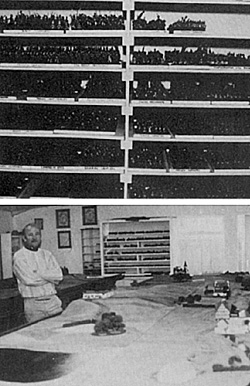 One of numerous shelves holding trays of Napoleonic figures. About 550 infantry or 200 cavalryman each tray. We are talking about very big battles here! Photo by Arnold.
One of numerous shelves holding trays of Napoleonic figures. About 550 infantry or 200 cavalryman each tray. We are talking about very big battles here! Photo by Arnold.
Roads and rivers are uniform in size and enter and leave the boards at the midpoints so they can match the next board. Woods and buildings are placed on top of the boards. Peter finds this gives more flexibility than if he fastened these items to the boards. His hedges are made from rubberized horsehair (if any reader figures out where he can buy this in America please let me know) in narrow rubber strips. Not only is this durable and extremely realistic, the hedges mold to undulating terrain so they can be placed in both hills and flatlands.
Since he needs tremendous numbers of trees, Peter has found a cheap way to make his own. He buys long, cylindrical wire brushes, cuts them in half, trims them into a tree shape, adds glue, rolls them in flock and the result is an excellent tree. To prove their durability he tosses one across the table. Startled, thinking about my own artistic but fragile items, I fumble the catch. It doesn't matter. These trees are built to last.
Monday; the players and figures are gone but the terrain remains. Peter stands by the Pratzen Heights featured in the weekend's Austerlitz simulation. Photo by Arnold.
Peter's beautiful buildings so often featured in Miniature Wargames magazine are simplicity themselves. He cuts basic wood shapes using a power saw. A dark brown water based paint mixed with fine mortar is applied to give the building a stucco look. Windows and doors are painted in and the whole is topped with a tile roofing sheet purchased from a model railroad shop.
Peter emphasizes the use of texture to create a visually appealing table top. The September issue of Military Wargames showed highlanders standing in waist high wheat facing French lancers. it was quite simply the most realistic wheat field anyone had ever seen. I asked Peter how he did it. Like so much Peter does, it's ridiculously simple. He carved up sections of doormat, laid them on his terrain sections, added some loose 'wheat' cut from the mat, and had his field. Upon my return I hurried out to the store, bought a yellow-brown coconut mat doormat, and now have wonderful ripe corn and wheat fields too.
As I drive back from Peter's small village along a mist covered road I look out at the rolling Yorkshire landscape. Hedges bisect the fields (are they rubberized horsehair?) and for a moment I'm not sure whether I'm in the York countryside or gazing upon Peter Gilder's marvelous Enchanted Cottage.
1812 AMERICAN FLAGS
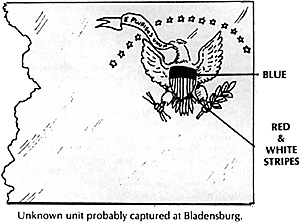 Captured by British
Captured by British
Unknown unit probably captured at Bladensburg.
White eagle; middle of eagle in shield; below, eagle holds green laurels & black sticks; 14 white stars; field in pink/red. Inscription: "E Pluribus Unum" on scroll.
This shield design on all flags where shield is noted.
LIGHT DRAGOONS
Captured at Bladensburg
Blue field; 7 stars; two scrolls intertwined with rattlesnake. Top scroll reads "First Har...d. A Light Dragoons". Lower scroll reads "Touch Me Not". Note: one or two blanks in unit's name.
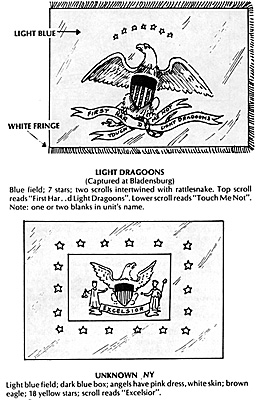 UNKNOWN NY
UNKNOWN NY
Light bluefield; dark blue box; angels have pink dress, white skin; brown eagle; 18 yellow stars; scroll reads "Excelsior".
JAMES CITY LIGHT INFANTRY
Captured at Bladensburg
Top inscription: "E Pluribus Unum" (in beak). Middle scroll: "68th Regiment". Bottom scroll: "James City Light Infantry"; white field, blue scroll. Reverse: standing female figure w/helmet carrying in left hand flag w/four red stripes on white ground; inset flag has liberty cap; at her feet a man is seated in front of stars and stripes. Three inscriptions: top reads "Virginia"; bottom two same as other side.
4TH INFANTRY
Blue field; eagle holds laurels; 14 yellow stars; inscription reads "The Fourth Reg of Infantry". Same style with curved scroll on bottom for 2nd Infantry. it haswhite field, blue scroll. Inscription: "Second Regiment U.S. Infantry".
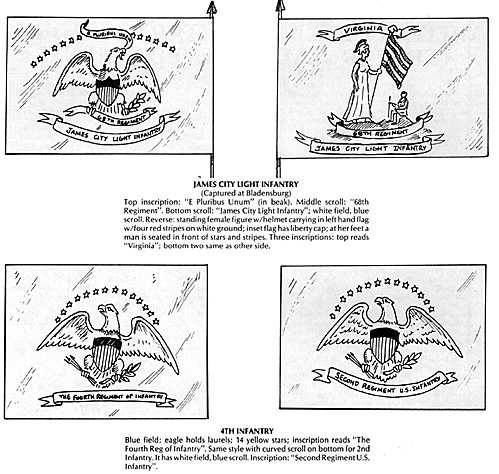
Back to Table of Contents -- Courier Vol. VII #4
To Courier List of Issues
To MagWeb Master Magazine List
© Copyright 1987 by The Courier Publishing Company.
This article appears in MagWeb (Magazine Web) on the Internet World Wide Web.
Other military history articles and gaming articles are available at http://www.magweb.com